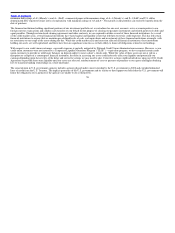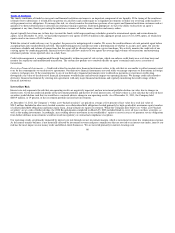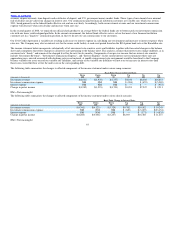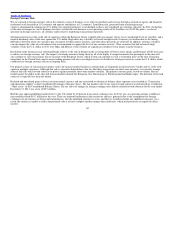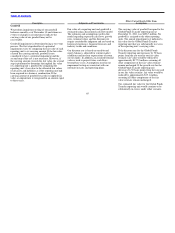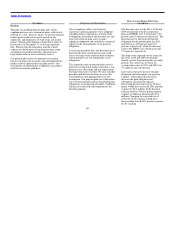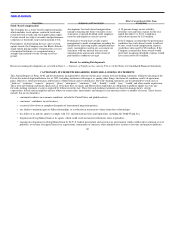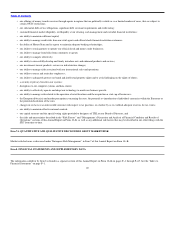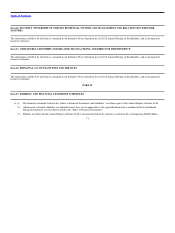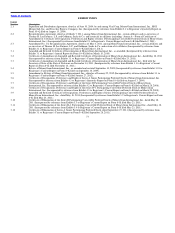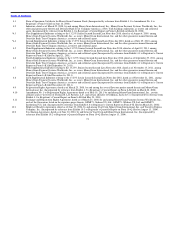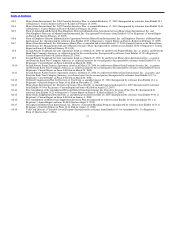MoneyGram 2011 Annual Report Download - page 68
Download and view the complete annual report
Please find page 68 of the 2011 MoneyGram annual report below. You can navigate through the pages in the report by either clicking on the pages listed below, or by using the keyword search tool below to find specific information within the annual report.
Table of Contents
Description Judgments and Uncertainties
Effect if Actual
Results Differ From
Assumptions
Income Taxes – Tax Contingencies
We are subject to income taxes in the United States
and various foreign jurisdictions. In determining
taxable income, income or losses before taxes are
adjusted for various differences between local tax
laws and generally accepted accounting principles.
We file tax returns in various states within the
United States and various countries. Our tax filings
for various periods are subject to audit by various tax
authorities, with United States federal income tax
filings for 2005 and 2009 subject to audit.
The benefits of tax positions are recorded in the
income statement if we determine it is
more−likely−than–not, based on the technical merits
of the position, that the tax position will be sustained
upon examination, including any related appeals or
litigation.
Changes in tax laws, regulations, agreements
and treaties, foreign currency exchange
restrictions or our level of operations or
profitability in each taxing jurisdiction could
have an impact on the amount of income taxes
that we provide during any given year. The
determination of taxable income in any
jurisdiction requires the interpretation of the
related tax laws and regulations and the use of
estimates and assumptions regarding significant
future events, such as the amount, timing and
character of deductions and the sources and
character of income and tax credits.
These assumptions and probabilities are
periodically reviewed and revised based upon
new information.
Changes in our
current estimates
due to unanticipated
events, or
other factors, could
have a material
effect on our
financial condition
and results of
operations.
Actual tax amounts
may be materi
ally different from
amounts
accrued based upon
the results of
audits due to
different inter
pretations by the tax
authorities
than those of the
Company. While
we believe that our
reserves are
adequate to cover
reasonably
expected tax risks,
an unfavorable
tax settlement
generally requires
the use of cash and
an increase in
the amount of
income tax expense
that we recognize.
A favorable tax
settlement generally
requires a
decrease in the
amount of income
taxes that we
recognize.
Income Taxes—Valuation of Deferred Tax Assets
Deferred tax assets and liabilities are recorded based
on the future tax consequences attributable to
temporary differences that exist between the
financial statement carrying value of assets and
liabilities and their respective tax basis, and
operating loss and tax credit carry−backs and
carry−forwards on a taxing jurisdiction basis. We
measure deferred tax assets and liabilities using
enacted statutory tax rates that will apply in the years
in which we expect the temporary differences to be
recovered or paid.
The carrying amount of deferred tax assets must be
reduced through a valuation allowance if it is
more−likely−than−not the deferred tax asset will not
be realized.
In the period in which a valuation allowance is
recorded, we would record significant tax expense,
whereas a tax benefit would be recorded in the
period a valuation allowance is reversed.
In assessing the need for a valuation allowance,
we consider both positive and negative evidence
related to the likelihood that the deferred tax
assets will be realized. Our assessment of
whether a valuation allowance is required or
should be adjusted requires judgment and is
completed on a taxing jurisdiction basis.
We consider, among other matters: the nature,
frequency and severity of any cumulative
financial reporting losses; the ability to carry
back losses to prior years; future reversals of
existing taxable temporary differences; tax
planning strategies; and projections of future
taxable income.
We also consider our best estimate of the
outcome of any on−going examinations based
on the technical merits of the position, historical
procedures and case law, among other items.
As of December 31,
2011, we
have recorded a
valuation allow
ance of $476.3
million against
gross net deferred
tax assets of
$546.1 million. The
valuation
allowance primarily
relates to our
tax loss carryovers
and basis dif
ference in revalued
investments.
While we believe
that the basis for
estimating our
valuation allowance
is strong, changes
in our current
estimates due to
unanticipated
events, or other
factors, could have
a material effect on
our financial
condition and
results of
operations.
67



